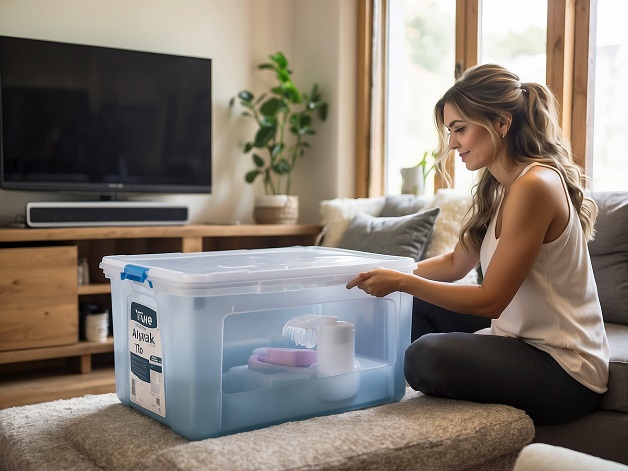
In today’s busy world jam-packed with commitments and obligations, simplifying life has become a way to find some peace and balance. Welcome to my comprehensive guide on es for downsizing and decluttering strategies– two fundamental practices that hold the keys to a more harmonious and fulfilling lifestyle.
Downsizing refers to intentionally reducing the size, scale, or quantity of possessions, living space, or lifestyle. It’s often to streamline and simplify your life. It involves transitioning to a smaller home, minimizing belongings, or embracing a more intentional and efficient way of living.
Decluttering is the deliberate process of removing unnecessary items or clutter from living spaces. It involves organizing and purging personal possessions to create a more organized, functional, and clutter-free environment. This has greatly promoted mental clarity and a sense of calm in my life.
Both downsizing and decluttering play crucial roles in simplifying life by reducing distractions and chaos. Therefore, it has allowed me to focus on what truly matters, reducing stress, and fostering a more intentional lifestyle.
These practices contribute to creating a harmonious living environment by cultivating organized spaces that promote peace, relaxation, and functionality. A clutter-free space has supported my emotional well-being, enhanced productivity, and created a tranquil atmosphere conducive to better living.
If this is what you are seeking, follow along so I can share with you what I learned on my journey.
Downsizing Tricks That Work in Real Life

Downsizing Methods for Different situations:
Moving: When I moved, I prioritized essentials and downsizing by choosing items based on personal functionality and necessities. I scaled down furniture and utilized vertical storage solutions to fit into my new space.
Lifestyle Changes: For those who are at a turning point like retirement or becoming an empty nester, adapt items to your new lifestyle. Layout functional spaces that align with your changed lifestyle while decluttering non-essential items.
I got rid of my full couch and instead got a loveseat for just me and my dog.
Embracing Minimalism: I embraced minimalism by adopting a mindful approach to purchases and focused on routine decluttering. Additionally, I focused on making intentional choices, keeping only items that add value or bring joy to me. This allowed me to avoid unnecessary acquisitions or purchases.
The Benefits About Downsizing My Life

My top benefit was financial flexibility by reducing housing expenses, lowering utility bills, decreasing maintenance costs, and generated some income from selling unneeded items. Downsizing has boosted my savings account and financial freedom.
Another benefit I noticed was the environmental friendliness that comes with downsizing. I reduced energy consumption, minimized waste generation, and reduced my carbon footprint due to living in a smaller, more efficient space, which promotes sustainability.
Positives About Downsizing Your Life

Practical steps for decluttering involve starting small, sorting items into categories (keep, donate, discard), utilizing the “one in, one out” rule (you buy a new item, you get rid of an old item), setting specific time limits for decision-making, and organizing spaces systematically. I began by tackling one area at a time. This allowed me to commit to regular decluttering sessions to maintain a clutter-free home.
By maintaining an organized living space, I noticed how it positively impacted my mental health. This improved my stress and anxiety, enhanced my focus and productivity, and foster a sense of control. Additionally, it created a calming and harmonious environment that improved my overall well-being.
Rock-Solid Tips for Clearing the Clutter
Efficient storage solutions involve maximizing space utilization through multi-functional furniture, utilizing vertical storage like shelves or wall-mounted organizers, and employing storage containers or baskets for better organization.

My organizational strategies include:
- Labeling boxes or totes
- grouping similar items together
- using clear containers for easy visibility
- regularly reassessing and reorganizing to maintain orderliness.
Furthermore, sustaining a clutter-free environment involves implementing habits such as:
- Daily tidying
- Assigning specific places for items
- Scheduling regular decluttering sessions
- Adopting a “one in, one out” rule when bringing in new items.
I made sure to remain consistent with organizing and implemented periodic reassessment of item placement. Additionally, I am committed to managing items as it helps prevent clutter buildup, ensuring I keep a consistent organized living space.
Real-Life Downsizing and Decluttering strategies

Real-life examples of successful downsizing and decluttering strategies experiences often include respecting minimalism and finding contentment in simplified living.
For example, I can attest that letting go of things will set your soul free. Because of this, my story illustrates how downsizing improved my quality of life, reduced stress, increased financial freedom, and allowed me to focus on what truly matters.
It showed me the emotional and practical benefits of downsizing, hopefully inspiring you to consider similar lifestyle changes for a more fulfilling and intentional life.
Additionally, my commitment has taught me new lessons, prioritizing the significance of experiences over possessions, relationships, and finding contentment in simplicity. I hope my story inspires others to reevaluate their priorities, cultivate gratitude, and seek fulfillment beyond material possessions.
Lastly, it promoted emotional richness and freedom found in intentional living, encouraging me to embark on a journey towards a more meaningful and purposeful life.
Wrapping It Up: What Downsizing and Decluttering Strategies Really Mean for me
I hope my guide to downsizing and decluttering is evident that these practices offer a transformative path to a more intentional and harmonious lifestyle. By understanding the essence of downsizing and decluttering, embracing practical strategies, and witnessing real-life examples of successful transitions, you can appreciate the profound benefits.
The journey toward intentional living isn’t solely about physical possessions; it’s about reclaiming time, reducing stress, and nurturing mental well-being. From downsizing methods tailored to specific needs to the psychological benefits of maintaining an organized space, each aspect contributes to a more fulfilling life.
Remember, power lies in the consistent application of these principles. By implementing these tips, utilizing efficient storage solutions, and maintaining a commitment to regular decluttering, you can create and sustain a clutter-free environment conducive to peace and contentment.
Finally, I hope my story serves as a beacon of inspiration. My lessons underscore the importance of valuing experiences, fostering gratitude, and finding joy in simplicity. As you embark on your own journey toward intentional living, may this guide serve as a roadmap, encouraging you to seek a life filled with purpose, mindfulness, and the joy of living with less.
FAQ’s – Downsizing and Decluttering Strategies
How to downsize quickly?
To downsize quickly:
- Prioritize essentials: Focus on what’s necessary and let go of non-essential items.
- Set a strict timeline: Establish deadlines for decluttering and stick to them.
- Declutter ruthlessly: Make swift decisions about what to keep, donate, sell, or discard.
- Utilize a sorting system: Categorize items efficiently to streamline the downsizing process.
- Seek help if needed: Enlist support from friends or family to expedite the downsizing process.
How to downsize without moving?
To downsize without moving:
- Assess possessions: Evaluate belongings and declutter items not regularly used or needed.
- Maximize space: Utilize storage solutions like shelves, organizers, and multifunctional furniture.
- Regular decluttering: Adopt a habit of periodic decluttering to maintain a streamlined living space.
- Adapt to needs: Adjust possessions to fit lifestyle changes and prioritize functionality over excess.
Do you have a downsizing home checklist?
- Assess belongings: Evaluate items and decide what to keep, donate, sell, or discard.
- Room-by-room decluttering: Start with one area at a time to streamline the process.
- Organize documents: Sort and organize important documents, keeping only what’s necessary.
- Measure new space: Ensure furniture fits the new space before moving.
- Utilize storage efficiently: Use space-saving solutions for better organization.
- Plan the move: Arrange logistics for the move, including hiring movers or seeking help if needed.
What are some declutter tips for moving?
Declutter tips for moving:
- Start early: Start decluttering well in advance of the move.
- Sort belongings: Categorize items into keep, donate, sell, or discard piles.
- Pack efficiently: Pack only what you’ll need in the new home.
- Dispose responsibly: Properly dispose of or donate items you won’t be taking.
- Label boxes: Clearly label boxes to stay organized during the move.
Consider professional help: Hire movers or enlist assistance if required.
